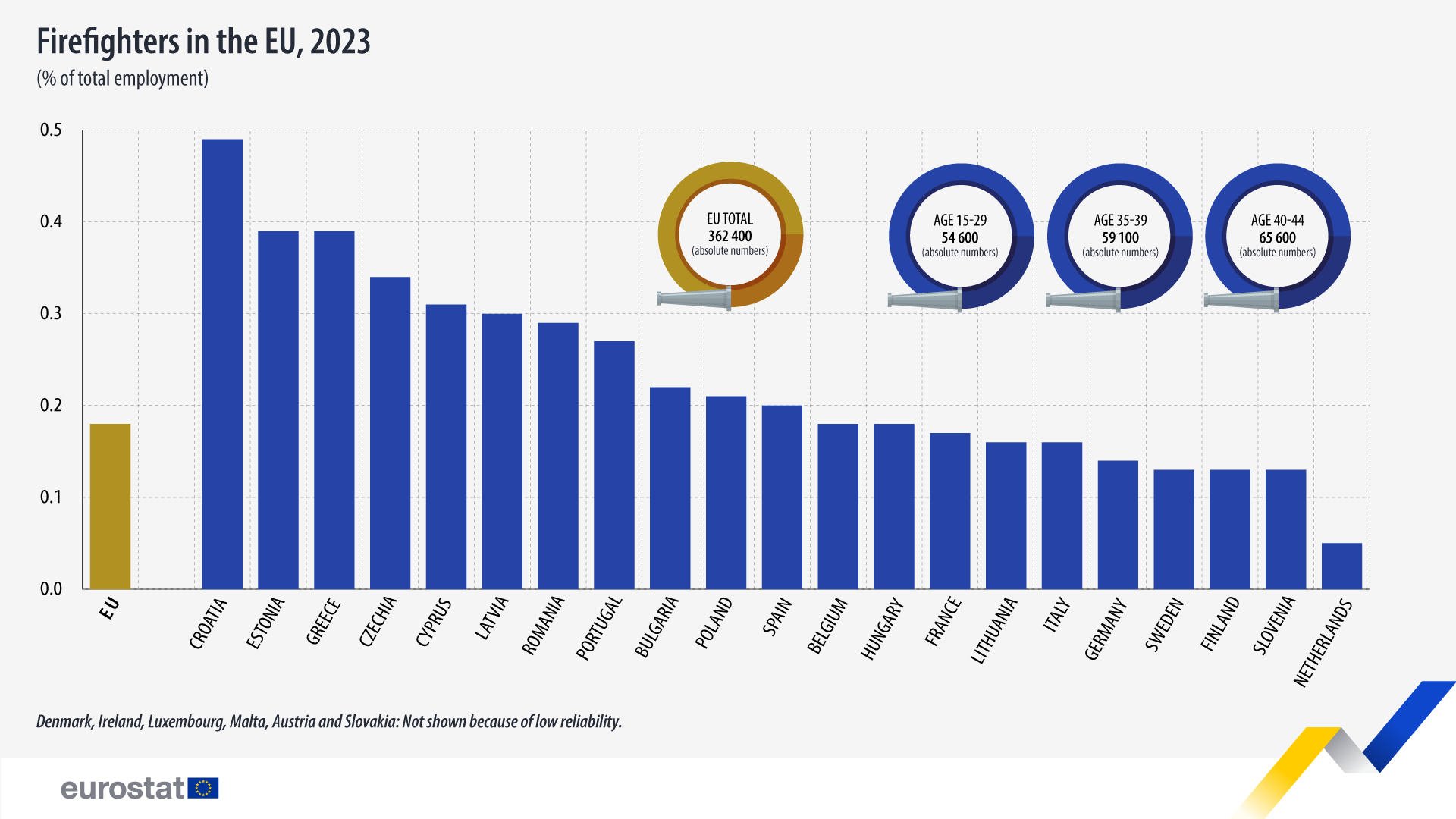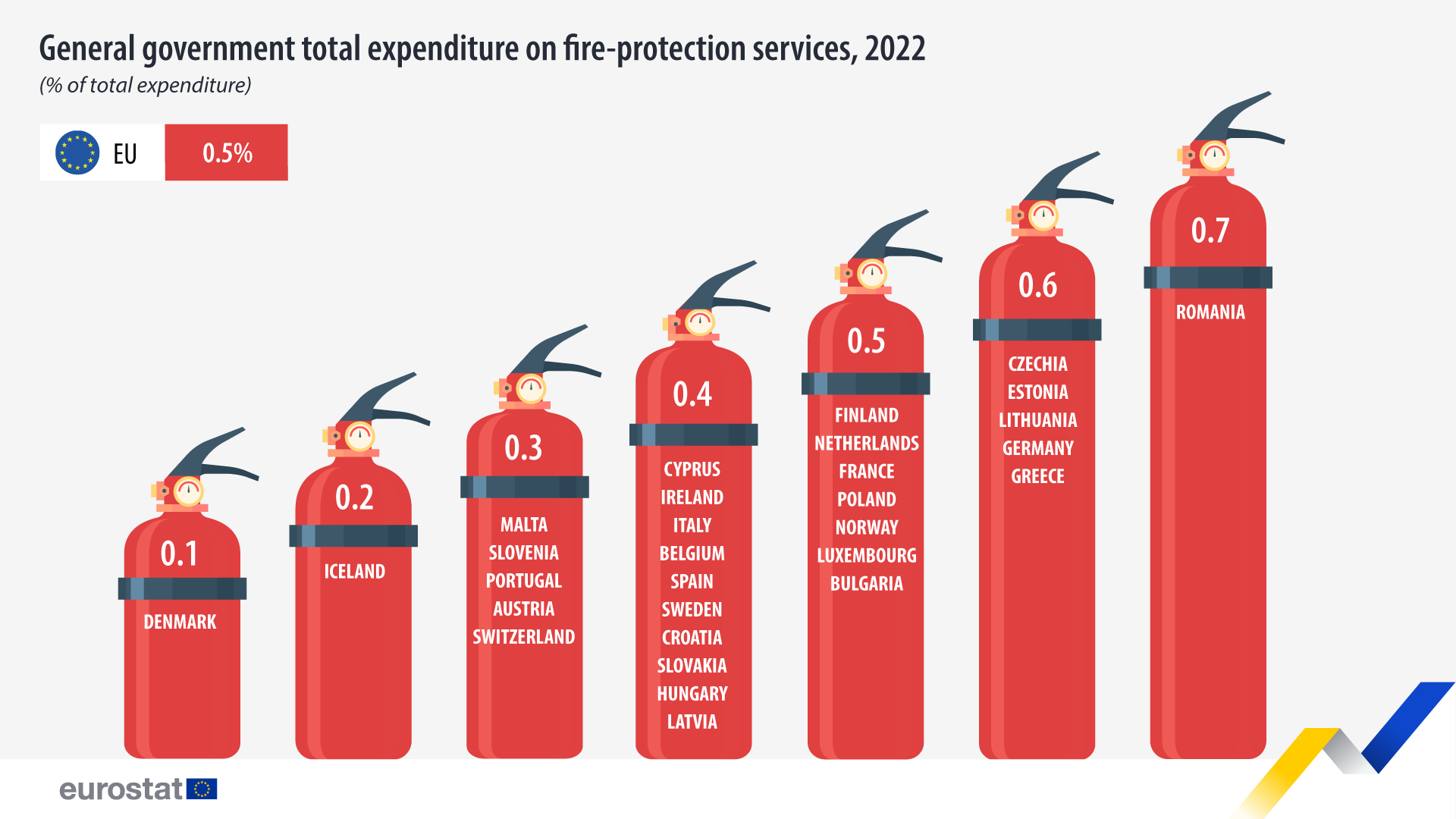EU relies on over 360 000 professional firefighters

In 2023, there were 362 400 professional firefighters in the EU, representing 0.18% of total EU employment. Compared with 2022, the number of firefighters increased by 3 200.
Among the 21 EU countries with available data, the highest shares of firefighters in total employment were registered in Croatia (0.49%), followed by Estonia and Greece (both 0.39%). The lowest shares were registered in the Netherlands (0.05%), Finland, Slovenia and Sweden (both 0.13%).
At the EU level, firefighters aged 30 to 49 made up 61% of all firefighters. Among them, the largest subgroups were those aged 40 to 44 (65 600 firefighters), followed by those aged 35 to 39 (59 100 firefighters).
Source dataset: Labour Force Survey extraction
EU governments spent €37.8 billion on fire-protection services in 2022
In 2022, general government expenditure on ‘fire-protection services’ in the 27 EU countries amounted to €37.8 billion, reflecting a 7.8% increase from 2021 (€35.1 billion).
The share of general government total expenditure in the EU dedicated to fire-protection services was 0.5%. Overall, government expenditure on fire-protection services has remained stable at 0.5% of total expenditure since 2016.
Source dataset: gov_10a_exp
In 2022, Denmark reported the lowest share of expenditure on fire-protection services, at 0.1% of general government total expenditure, followed by Malta, Slovenia, Portugal and Austria with 0.3% each.
In contrast, Romania had the highest share of expenditure on fire-protection services at 0.7% of total expenditure, followed by Greece, Germany, Lithuania, Estonia and Czechia with 0.6% each.
For more information
- Thematic section on employment and unemployment (Labour Force Survey - LFS)
- Database on employment and unemployment (Labour Force Survey - LFS)
- Thematic section on government finance statistics
- Database on government finance statistics
- Interactive infographic on government expenditure by function
- Online publication on general government expenditure by function
Methodological notes
- Firefighters refer to the category '5411 Firefighters', as defined under the International standard classification of occupations (ISCO-08) classification. This category includes both firefighters and forest firefighters.
- Data on firefighters in 2023 from the EU Labour Force Survey are not shown for Austria, Denmark, Ireland, Luxembourg, Malta and Slovakia because of very low reliability.
- Low reliability data of the number of firefighters for Bulgaria, Croatia, Cyprus, Finland, Latvia, Lithuania and Slovenia.
- According to the methodology of the survey only people working in their main job as firefighters are included; voluntary workers, such as volunteer firefighters, are not included in employment statistics based on this activity.
- General government expenditure for the function 'fire protection services' (according to the Classification of the functions of government – COFOG) is based on national accounts/government finance statistics.
- ‘Fire protection services´ is part of the COFOG division ‘public order and safety’. According to the classification, it relates to the “administration of fire prevention and firefighting affairs and services; operation of regular and auxiliary fire brigades and of other fire prevention and firefighting services maintained by public authorities; operation or support of fire prevention and firefighting training programmes. It includes civil protection services such as mountain rescue, beach surveillance, evacuation of flooded areas, etc.”
- Manual on sources and methods for the compilation of COFOG statistics — Classification of the Functions of Government (COFOG)
- Metadata file on government expenditure by function.
- Data on government expenditure by function for the EU and euro area aggregates (2022), Belgium (2022), Germany (2020-2022), Spain (2022), France (2021-2022) and Portugal (2022) is provisional.
If you have any queries, please visit our contact us page.


